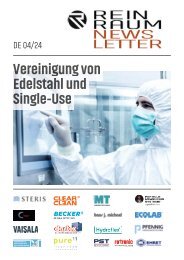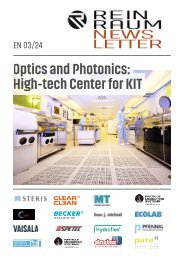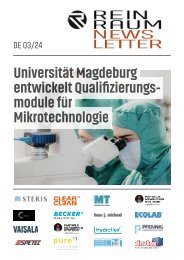Newsletter_04-2024_EN
Create successful ePaper yourself
Turn your PDF publications into a flip-book with our unique Google optimized e-Paper software.
From data glasses to robotic arms
– labs enter the digital age
The same developments happening in the rest of the world
are also reshaping laboratories: the increasing use of technology,
digital tools and, of course, robots and artificial intelligence
(AI). All these trends often go hand in hand with
a greater awareness of environmental issues. In this trend
report, we present a summary of the fruits these developments
are already bearing and will bear in the future.
The laboratory landscape is constantly changing. Whereas until the
middle of the 20th century people used their mouths to suck up
samples when pipetting, today‘s laboratories are equipped with the
appropriate technical aids to protect laboratory staff and make their
work easier. However, development has obviously not stopped with
pipettes and is now progressing rapidly, especially in the areas of automation,
digitalisation and robotics. We take a closer look at these
major laboratory trends and how they can also benefit sustainability.
In the beginning was automation
It almost seems like a relic of a bygone era: in the 1970s, as the third
industrial revolution (Industry 3.0) pushed the working environment
more and more towards automated processes. This led to an
increase in production output and created new opportunities in manufacturing
and engineering. At the same time, laboratories began
to move away from routine manual work towards more mechanical
support. However, it was not until the Fourth Industrial Revolution,
in the wake of digitalisation, that the formal breakthrough occurred.
Since then, progress in this area has been promoted and discussed
under the buzzword Laboratory 4.0.
The combination of basic tasks such as stirring, tempering, dosing,
etc. in automated processes laid the foundation for faster and
more repeatable laboratory work. Nowadays, virtually every piece of
laboratory equipment is at least partially automated – from the HPLC
system with pump unit and autosampler, to the fermenter with precisely
controlled temperature technology and media supply, to the
electronic pipette with support function for predefined workflows.
When we talk about automation in the laboratory today, it is inextricably
linked to digitalisation. „It is important to remember that
digitalisation alone is not enough – especially in the laboratory, automation
also includes a strong hardware component,“ says Prof. Dr
Kerstin Thurow from the Centre for Life Science Automation (CELI-
SCA) at the University of Rostock. Without suitable equipment and
systems for handling samples and labware, she says, it is not possible
to automate laboratory processes. „This is often overlooked or taken
for granted in today‘s discussion,“ she notes.
Ideally, a device combines automation and digitisation, as many
workstations do. These devices are usually equipped with their own
software that allows users to save their own workflows without the
need for programming skills. For example, pre-defined steps can be
dragged and dropped into the system to develop drug screens on a
PC, which are then automatically performed by a pipetting station.
This gives users more time for complex laboratory tasks such as
planning and evaluating experiments.
From automats to auto-arms
In addition to workstations, which usually fulfil a narrowly defined
task, robotic arms, familiar from industrial applications, are increasingly
being used in the laboratory. „In addition to classic Cartesian
liquid handling robots, various types of robotic arms are used when
highly complex systems consisting of several devices need to be
connected,“ explains automation expert Thurow. This type of robotic
arm, which is most commonly associated with automotive manufacturing,
can perform flexible movements that would otherwise
only be possible by a human arm – and it can do so with the precision,
endurance and repeatability of a machine. This is useful for
sample transfer or preparation, for example, and particularly in project-based
environments where workflows and tasks change more
frequently and require a more flexible solution.
To accommodate a robot assistant in the laboratory, which is
usually already constrained by a lack of space, modern robot arms
© shutterstock/586533194/Kitreel © iStock/1140779713/gorodenkoff
www.reinraum.de | www.cleanroom-online.com NEWSLETTER | Edition EN 04-2024
page 31/35
















